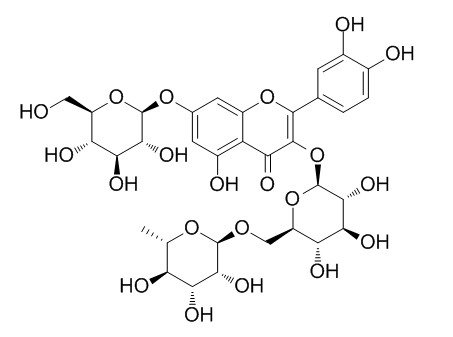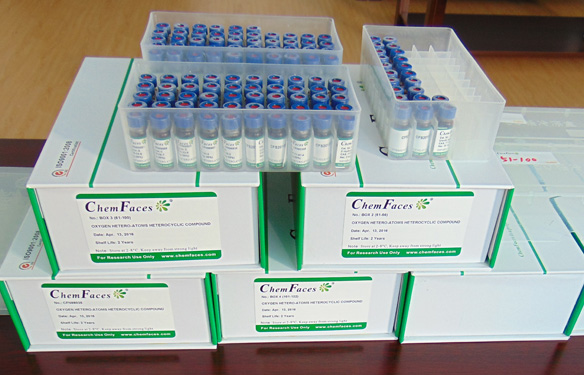Quercetin 3-rutinoside 7-glucoside (Morkotin A)
Reference standards.
Inquire / Order:
manager@chemfaces.com
Technical Inquiries:
service@chemfaces.com
Tel:
+86-27-84237783
Fax:
+86-27-84254680
Address:
1 Building, No. 83, CheCheng Rd., Wuhan Economic and Technological Development Zone, Wuhan, Hubei 430056, PRC
Providing storage is as stated on the product vial and the vial is kept tightly sealed, the product can be stored for up to
24 months(2-8C).
Wherever possible, you should prepare and use solutions on the same day. However, if you need to make up stock solutions in advance, we recommend that you store the solution as aliquots in tightly sealed vials at -20C. Generally, these will be useable for up to two weeks. Before use, and prior to opening the vial we recommend that you allow your product to equilibrate to room temperature for at least 1 hour.
Need more advice on solubility, usage and handling? Please email to: service@chemfaces.com
The packaging of the product may have turned upside down during transportation, resulting in the natural compounds adhering to the neck or cap of the vial. take the vial out of its packaging and gently shake to let the compounds fall to the bottom of the vial. for liquid products, centrifuge at 200-500 RPM to gather the liquid at the bottom of the vial. try to avoid loss or contamination during handling.
Asian J Beauty Cosmetol2024, 22(1): 103-112.
Nat Commun.2023, 14(1):8142.
J Exp Bot.2016, 67(12):3777-88
Asian Pac J Cancer Prev. 2020, 21(4):935-941.
Food Funct.2020, 11(2):1322-1333.
Preprints2022, 202211.0388.v1.
Saudi Pharmaceutical Journal2023, 31(12):101829
Biochem Pharmacol. 2020, 177:114014.
Environ Toxicol.2020, doi: 10.1002
LWT2020, 124:109163
Related and Featured Products
Phytochemistry, 1986, 25(6):1309-1313.
Flavonoid pigments in swallowtail butterflies.[Reference:
WebLink]
METHODS AND RESULTS:
Flavonoid pigments have been identified in the swallowtail butterfly Eurytides marcellus and its larval foodplant Asimina triloba (Annonaceae). Although quercetin 3-glycoside, quercetin 3-rutinoside and quercetin 3-rutinoside 7-glucoside are present in the plant, only quercetin 3-glucoside is sequestered by the insect. Flavonoids have also been found in 10 out of 27 other papilionid species examined. These were mainly 3- and 7-glycosides of the flavonols quercetin and kaempferol.
CONCLUSIONS:
The sequestration of flavonoids by papilionid butterflies appears to be related both to the phylogeny of the Papilionidae and to the choice of larval foodplants by the various phylogenetic groups.
Plant Systematics & Evolution, 1975, 124(1):57-66.
Leaf flavonoids ofGalium sect.Aparinoides (Rubiaceae).[Reference:
WebLink]
METHODS AND RESULTS:
13 taxa belonging to 4 “species groups” ofGalium L. sect.Aparinoides (JORD.)GREN. produce 15 leaf flavonoids: Apigenin-7-diglucoside, Luteolin-7-monoglucoside and 7-diglucoside, Diosmetin, Diosmetin-7-monoglucoside and 7-diglucoside; Kaempferol-3-rutinoside, Kaempferol-3,7-diglucoside, Quercetin, two Quercetin-3-monoglycosides, Rutin, Quercetin 3-rutinoside 7-glucoside, Quercetin-7-glycoside and an unidentified aglycone. TheG. trifidum, G. obtusum andG. palustre groups (with the exception of theG. tinctorium subspecies andG. elongatum) have similar flavone-flavonole patterns, while theG. antarcticum group produces a specific pattern. Leaf flavonoids of theG. trifidum andG. antarcticum group are inhomogenous, becauseG. tinctorium subsp.tinctorium andG. antarcticum lack flavones.
CONCLUSIONS:
For all taxa (with the exception of those of theG. antarcticum group) intraspecific variation is demonstrated, and 4 populations ofG. trifidum subsp.trifidum, G. tinctorium subsp.tinctorium,G. obtusum subsp.obtusum andG. labradoricum even exhibit intrapopulation variation. The implications of flavonoid data on the systematics and the astonishing intrapopulation and intraspecific variation are discussed.
Naringin 4'-glucoside
Catalog No: CFN95014
CAS No: 17257-21-5
Price: $338/5mg
Fargesol
Catalog No: CFN95027
CAS No: 128855-64-1
Price: $318/20mg
Prionanthoside
Catalog No: CFN95206
CAS No: 161842-81-5
Price: $318/10mg
(1E)-3-methoxy-8,12-epoxygermacra-1,7,10,11-tetraen-6-one
Catalog No: CFN95219
CAS No: 1393342-06-7
Price: $413/5mg
2-Methoxyfuranoguaia-9-ene-8-one
Catalog No: CFN95220
CAS No: 88010-62-2
Price: $318/10mg
Eschweilenol C
Catalog No: CFN95363
CAS No: 211371-02-7
Price: $318/10mg
7-O-(4-beta-D-glucopyranosyloxy-3-methoxybenzoyl)secologanolic acid
Catalog No: CFN95365
CAS No: 469899-55-6
Price: $368/5mg
3-O-Methylellagic acid 3'-O-alpha-rhamnopyranoside
Catalog No: CFN95375
CAS No: 352280-34-3
Price: $413/5mg
3'-Hydroxy-5,7,4',5'-Tetramethoxyflavone
Catalog No: CFN95397
CAS No: 29976-51-0
Price: $318/5mg
1,3,4,6-Tetragalloylglucose
Catalog No: CFN95425
CAS No: 26922-99-6
Price: $318/10mg



